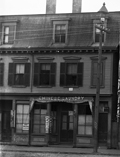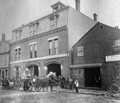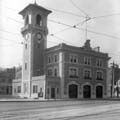|
The Society
Historical Information
Photo & Map Collections
Exploring Brookline
Links
Program Archives
|
Brookline Village
 |
Lower Washington St. August, 1933
Looking east from the Village Square
[Source: Leo Sullivan]
|
 |
Sing Lee Chinese Laundry, Lower Washington St., circa 1891
Just east of the intersection of High St. and Boylston, next to Hose House #1. Torn down before 1908 for the construction of the present day firehouse. Orignally numbered 66 before renumbering of Washington St.
1) Note the "Employment Office" sign by the entrance to the stairs next door at #68. This was likely the office of Mrs. Benjamin Hill. Brokers like this were often the source of servants for the wealthy households of Brookline.
2) Note the "Board Rooms" sign on the second floor. Listed in the city directory as boarders at that address are Thomas Steward, hairdresser and Joseph Hartnett, carriage painter, who worked at Michael Quinlan’s carriage factory one block away at the southwest corner of High St. and Boylston St.
3) Note the "Ladies Pompadours Cut and Curled" sign to the left at the hair salon next door.
|
 |
Hose #1 House, Lower Washington St., Brookline Village, circa 1905
Formerly Good Intent Hose Company. Note mural in middle of façade.
|
 |
South Side, Lower Washington St., 1905
The stores are bedecked with banners celebrating the bicentennial These buildings were all demolished in 1907-1908 and the current fire station was opened on this site in 1909.
[Source: Digital Commonwealth]
|
 |
Lower Washington St., Brookline Village, circa 1905
The businesses viewed here, along the south side of Lower Washington St., were simultaneously sited at this location from 1904 - 1906. All the structures in this photo were demolished in 1907-1908 to make way for the new fire station which opened in 1909 and remains in use today. Note the man with his wheeled bucket, center photo, presumably scooping up horse droppings. Viewed from left to right:
- The business with the partial view of an awning is at the corner with Walnut St., the last building in this row. The best estimation is that it is the store of James Heleotis and John Sigalos Co., fruit [1904-1906]. The awning appears to advertise "Ice Cream Sodas" mirroring the sign at the corner entranceway visible in other photos.
- An enigmatic sign over the alleyway that seems to advertise a shooting gallery. This is currently unidentified.
- By the delivery wagon at #126 Washington St. are William Frawley, shoemaker [1889-1907]; and a bootblack, either W. L. Jacklin [1904] or Cromwell Felton [1905-1907].
- C. E. Riley, Cigars at #128 Washington St. [1900-1907]
- The awning at 134 Washington St. George W. Rix, Provisions and Transfer Market [1904-1907]
- Sing Lee, laundry, which was at #136 Washington St. for over 20 years [1883-1907]
- Hose House #1 and Chemical Engine #1 at #140 Washington St.
- P. J. Burns, Horse Shoe Forge at #144 Washington St. [1897-1907]
- Also at 144 Washington St. there remains a sign for R. Woodward who had a horse-shoeing business there from the 1860s until his death in 1892
- J. H. Pineo, carpenter and builder at 4 High St. (visible at corner of Washington St) [1901-1907]
|
 |
P. J. Burns, Horse Shoeing, Brookline Village, 1905
South side of Lower Washington St., #144, corner High St. Hose House 1 is partially visible on the left. Right rear, #4 High St. is partially visible. The fire station is showing banners for the 1905 bicentennial. These buildings were all demolished in 1907-1908 and the current fire station was opened on this site in 1909.
[Source: Digital Commonwealth]
|
 |
Memorial Day, 1923; Lower Washington St., Brookline Village
The Stephen F. Rutledge V.F.W Post #864. P. H. Tonra, Commander. Lower Washington St., Brookline Village. Stores are no longer standing. Current fire house visible, right rear. Edward Moloney is standing under the "JT Driscoll Plumbing" sign, he is the one in a hat instead of a helmet.
|
 |
Lower Washington St., circa 1875
Start of Boylston St. to the right going west; lower Washington St. toward Boston to the left. The structures to the left of the fire station were collectively known as “White’s Block”. On the far left on the corner with Walnut St. is a boarding house. In the middle is the sign for Thomas Mayo & Co. which sold furnaces, stoves, and kitchen goods. Immediately to the left of the station is the store of Frederick Sigwart, Cigars.
In the early 1870s the town was progressing to an organized fire-fighting system after years of more haphazard efforts. It created a Fire Department Board of Engineers. It funded this brick building, constructed at significant cost, that was completed in January 1872. In these early years fire houses were designated according to the piece of equipment they hosted. On the left is the Good Intent Hose Company (the hose wagon is pictured in front) which was organized in 1865 and disbanded May 11, 1875. On the right is the Thomas Parsons Steam Fire Engine.
From stereoscope. "Engine and Hose House, Brookline. E.R. Hills, Photographer, Brookline Mass.” Gift of Natick Historical Society.
|
 |
Lower Washington St., circa 1875
Start of Boylston St. to the right going west; lower Washington St. toward Boston to the left. The structures to the left of the fire station were collectively known as “White’s Block”. To the right is the shop of Royal Woodward, Blacksmith.
In the early 1870s the town was progressing to an organized fire-fighting system after years of more haphazard efforts. It created a Fire Department Board of Engineers. It funded this brick building, constructed at significant cost, that was completed in January 1872. In these early years fire houses were designated according to the piece of equipment they hosted. On the left is the Good Intent Hose Company which was organized in 1865 and disbanded May 11, 1875. On the right is the Thomas Parsons Steam Fire Engine (the steam wagon is pictured in front).
[Source: Brookline Public Library]
|
 |
Hose House #1, Brookline Village, 1891
Decorated, in a deliberately macabre fashion, for the annual Horribles Parade, 7/4/1891, for which it won the best-decorated building town prize.
|
 |
Fire Station #1, Brookline Village, circa 1908
Washington St. in foreground coming from Huntington Ave. Boston, looking west to Boylston St. Hose House #1 and adjacent buildings torn down. New station completed in 1908 and is still in use today.
|
 |
Fire Station #1, Brookline Village, 1909
Trolley station not yet evident.
From postcard mailed October 8, 1909 by Katie, 150 Cypress St. Brookline
|
 |
Fire Station #1, Brookline Village, 1909
|
 |
Fire Station #1, Brookline Village, circa 1910
Trolley station erected. Small bushes planted on side of station.
|
 |
Fire Station #1, Brookline Village, 1910
The 1909 Knox chemical and hose wagon, the first motorized fire-fighting vehicle purchased by the town. It was known as "Combination A" and ushered in the end of the horse-drawn era. Pictured are:
- George Murray, driver
- John Allen, Assistant Chief, next to the driver
- John O’Neil, rear, first on the left
- Two unidentified men, rear left
- Lt. Frank T. Pons, Sr., at the back
- Lt. Frank Hayes, Sr., rear right
[ref. The Brookline Chronicle, August 22, 1968, pg. 1]
|
 |
Brookline Village, circa 1910
Fire station #1 and the new trolley island
|
 |
Brookline Village, circa 1910
Washington St., looking west toward Boylston St. From left to right:
- [108 Washington St.] a partial view of Frank Fine, florist
- [34 Walnut St.] J. Edward Kirker, Real Estate (sign on roof)
- [38 Walnut St.] Marks Bergstein, tailor
- [40 Walnut St.] Eagle Hand Laundry
- [Walnut & High] the Union Building which housed the Brookline Friendly Society
- [140 Washington St.] New fire station completed in 1908 and still in use today
- Inbound trolley
- [#166 Washington St.] The Brookline Print sign visible on the Guild Block building
[Source: Joel Shield]
|
 |
Fire Station #1, Brookline Village, 1912
Bushes are larger.
|
 |
Brookline Village, 1920
Looking west on Washington St. toward the start of Boylston St.
Village Square, where Washington Street met today's Route 9, was the commercial center of Brookline from the 1840s until after the Civil War. Most of its commercial and residential buildings were replaced by office buildings during the urban renewal of the 1960s. Pictured here are the still existant 1908 fire station and the transfer stations of the Boston Elevated Railway. The rail route was replaced by a bus line in the 1930s, and the rails were removed for scrap steel during World War II.
|
 |
Brookline Village
|
|